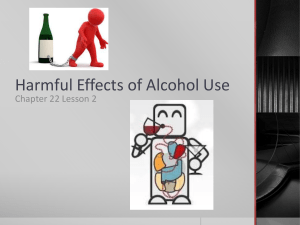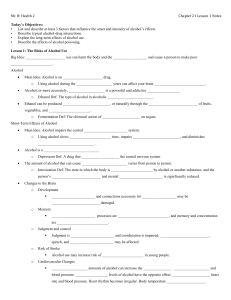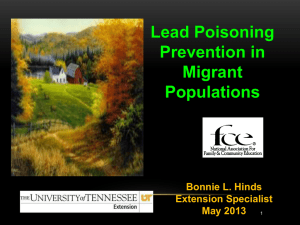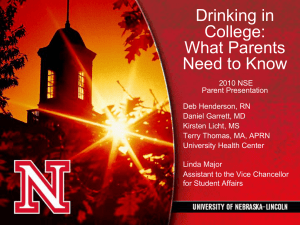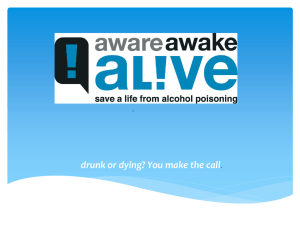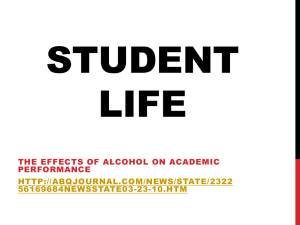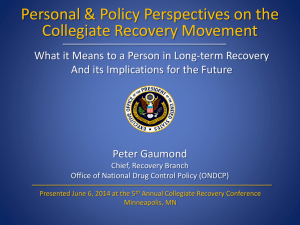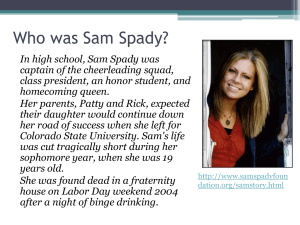22.2
advertisement
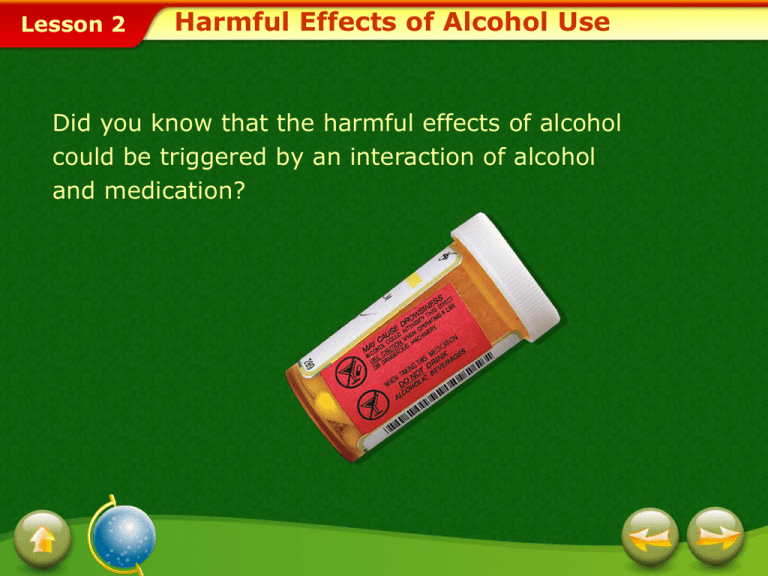
Lesson 2 Harmful Effects of Alcohol Use Did you know that the harmful effects of alcohol could be triggered by an interaction of alcohol and medication? Lesson 2 Lesson Objectives In this lesson, you’ll learn to: Examine the short-term effects of alcohol use. Associate risk-taking with consequences such as drinking and driving. Recognize the dangers of alcohol/drug interactions. Demonstrate refusal strategies concerning alcohol use. Lesson 2 Short-Term Effects of Drinking Factors Influencing the Effects of Alcohol Body size and gender A small person feels the effect of the same amount of alcohol faster than a large person does. In general, alcohol moves into the bloodstream faster in females. Food Food in the stomach slows down the passage of alcohol into the bloodstream. Amount and rate of intake As the amount of alcohol consumed increases, the level of alcohol in the bloodstream also rises. Lesson 2 Alcohol and Drug Interactions How the Body Works Interactions between medications and alcohol can lead to illness, injury, and even death. When a drug enters the body, it travels through the bloodstream to its target organ or tissue. Over time, the body metabolizes the drug. Alcohol travels through the bloodstream to the brain. At the same time, the liver metabolizes the alcohol in the bloodstream and makes it less active. Lesson 2 Alcohol and Drug Interactions Effects of Combining Alcohol and Drugs Alcohol combined with medicines or other drugs can result in a multiplier effect. Both prescription drugs and over-the-counter medicines, such as aspirin, can alter the ways in which alcohol affects the body. Labels on medicines that might cause reactions warn against combining them with alcoholic beverages. Lesson 2 Alcohol and Drug Interactions Typical Alcohol-Drug Interactions Alcohol may slow down a drug’s absorption by the body. Frequent drinking may increase the number of metabolizing enzymes in the body. Metabolizing enzymes can change some medications into chemicals that can damage the liver or other organs. Alcohol can increase the effects of some drugs. Lesson 2 Alcohol and Drug Interactions Short-Term Effects of Alcohol Physical and mental impairment begin with the first drink of alcohol and increase as more alcohol is consumed. Lesson 2 Driving Under the Influence Blood Alcohol Concentration A person is said to be intoxicated when his or her blood alcohol concentration (BAC) exceeds the state’s legal limit. In most states, driving while intoxicated is defined as having a 0.1 percent BAC, although in some states the figure is 0.08. Remember that for anyone under 21, there is no acceptable BAC percentage. Lesson 2 Driving Under the Influence Consequences of DWI Driving while intoxicated (DWI), also known as driving under the influence (DUI), is the leading cause of death among teens. The consequences of a teen caught DWI may include: Harm to the driver and others. Severely restricted driving privileges and/or immediate confiscation of a driver’s license. A police record and possible lawsuits. Arrest, jail time, court appearance, and a heavy fine or bail. Lesson 2 Binge Drinking What Is Binge Drinking? Recent studies show that binge drinking is a serious problem among young people. Rapid binge drinking (sometimes done on a bet or dare) is especially dangerous because it is possible to consume a fatal dose of alcohol. Binge drinking can cause alcohol poisoning. Lesson 2 Alcohol Poisoning Dangers of Over-Intake Alcohol acts as a depressant and shuts down involuntary actions such as breathing and the gag reflex that prevents choking. A fatal dose of alcohol will eventually stop these involuntary actions. It’s common for a person who has consumed too much alcohol to vomit because alcohol is a stomach irritant. If the involuntary actions are shut down, a person can choke and be asphyxiated by his or her own vomit. Lesson 2 Alcohol Poisoning Effects of Alcohol Poisoning Passing out is a common effect of drinking too much alcohol. Alcohol in the stomach and intestines continues to enter the bloodstream, and blood alcohol concentration continues to rise. For this reason, it’s dangerous to assume that a person who has consumed a lot of alcohol will be fine if left to “sleep it off.” Lesson 2 Alcohol Poisoning Symptoms of Alcohol Poisoning Symptoms that indicate alcohol poisoning include: Mental confusion, stupor, coma, inability to be roused, vomiting, and seizures. Slow respiration—10 seconds between breaths or fewer than 8 breaths a minute. Irregular heartbeat. Hypothermia, or low body temperature—pale or bluish skin color. Severe dehydration from vomiting. Lesson 2 Alcohol Poisoning Call 911 A person who exhibits signs of alcohol poisoning or has passed out may die if left untreated. If you suspect that a person has alcohol poisoning, call 911 immediately. Lesson 2 Quick Review Choose the appropriate option. Q. The amount of alcohol in a person’s blood expressed as a percentage is called _____. 1. blood alcohol concentration 2. binge drinking 3. metabolism 4. alcohol poisoning Lesson 2 Quick Review - Answer A. The amount of alcohol in a person’s blood expressed as a percentage is called blood alcohol concentration. Click Next to attempt another question. Lesson 2 Quick Review Provide a short answer to the question given below. Q. Define metabolism. Click Next to view the answer. Lesson 2 Quick Review - Answer A. Metabolism is the process by which the body breaks down substances. Click Next to attempt another question. Lesson 2 Quick Review Provide a short answer to the question given below. Q. What are the signs of alcohol poisoning? Click Next to view the answer. Lesson 2 Quick Review - Answer A. Signs of alcohol poisoning: Mental confusion, stupor, coma, inability to be roused, vomiting, and seizures Slow respiration—10 seconds between breaths or fewer than 8 breaths a minute Irregular heartbeat Hypothermia, or low body temperature—pale or bluish skin color Severe dehydration from vomiting Click Next to attempt another question. Lesson 2 Quick Review Provide a suitable explanation. Explain why it’s dangerous to mix alcohol and medications or other drugs. Lesson 2 Quick Review - Answer A. Correct! The amount of alcohol in a person’s blood expressed as a percentage is called blood alcohol concentration. Click Next to attempt another question. Lesson 2 Quick Review - Answer You have answered the question incorrectly. Go back to try again, or click Next to view the correct answer. Lesson 2 Alcohol and Drug Interactions How the Body Works Interactions between medications and alcohol can lead to illness, injury, and even death. When a drug enters the body, it travels through the Metabolism bloodstream to its target organ or tissue. Over time, the is the process by body metabolizes the drug. which the body down Alcohol travels through breaks the bloodstream to the brain. substances. At the same time, the liver metabolizes the alcohol in the bloodstream and makes it less active. Lesson 2 Driving Under the Influence Blood Alcohol Concentration A person is said to be intoxicated when his or her blood alcohol concentration (BAC) exceeds the state’s legal limit. In most states, driving while intoxicated is defined as having a Blood alcohol 0.1 concentration percent BAC, although in some states the figure is 0.08. (BAC) is the amount of Remember that for anyone under 21, there is no acceptable alcohol in a person’s BAC percentage. blood expressed as a percentage. Lesson 2 Binge Drinking What Is Binge Drinking? Recent studies show that binge drinking is a serious problem among young people. Rapid binge drinking (sometimes done on a bet or dare) Binge drinking is especially dangerous because it is possible to consume is drinking five or a fatal dose of alcohol. more alcoholic drinkspoisoning. at one Binge drinking can cause alcohol sitting. Lesson 2 Alcohol Poisoning Symptoms of Alcohol Poisoning Symptoms that indicate alcohol poisoning include: Mental confusion, stupor, coma, inability to be roused, vomiting, and seizures. Alcohol Slow respiration—10 seconds between poisoning is abreaths severe or fewer than 8 breaths a minute. and potentially fatal physical reaction to Irregular heartbeat. an alcohol overdose. Hypothermia, or low body temperature—pale or bluish skin color. Severe dehydration from vomiting.
